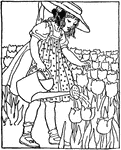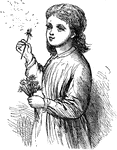
Comfrey (Longitudinal Section)
Comfrey (also comphrey) is an important herb in organic gardening, having many medicinal and fertilizer…

Sepal and Fruit of Comfrey
Comfrey (also comphrey) is an important herb in organic gardening, having many medicinal and fertilizer…

Viper's Bugloss Inflorescence
Echium vulgare (Viper's Bugloss) is a species of Echium native to most of Europe, and western and central…

Viper's Bugloss Flower
Echium vulgare (Viper's Bugloss) is a species of Echium native to most of Europe, and western and central…
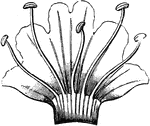
Viper's Bugloss Corolla and Stamens
Echium vulgare (Viper's Bugloss) is a species of Echium native to most of Europe, and western and central…

Plantain Flower and Bract
An illustration of a plantain plant flower and bract. In botany, a bract is a modified or specialized…
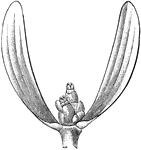
Pistillate Flowers of Mistletoe
An illustration of pistillate flowers of mistletoe. Mistletoe is the common name for a group of hemi-parasitic…
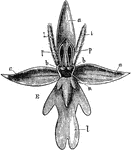
Fly Orchid
Fly orchid (Ophrys insectifera) is a plant of the family Orchidaceae, a native of the British Isles…

Encarpus
"In architecture, a sculptured ornament in imitation of a garland or festoon of fruits, leaves, or flowers,…
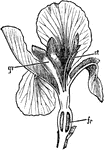
Iris
Iris is a genus of between 200-300 species of flowering plants with showy flowers. It takes its name…

Turk's Cap Lily
Lilium martagon (Martagon or Turk's cap lily) is a species of lily. It has a widespread native region…
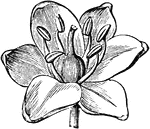
Scilla
Scilla (squill) is a genus of bulb-forming perennial herbs in the Hyacinthaceae. The 90-odd species…

Lily of the Valley
Convallaria majalis, commonly known as the Lily of the Valley or Lily-of-the-Valley, is the only species…
Common Heath
The flowering branch of the Common Heath (Epacris impressa), a plant in the Ericaceae family of heaths.

Trailing Arbutus
The Trailing Arbutus (Epigaea repens) is a spreading shrub in Ericaceae family of heaths.

Hepatica
An illustration of liverwort (Hepatica): a, Thalloid stem with female branches; b, Thalloid stem with…

Coca
The flowering branch of the coca plant (Erythroxylon coca) best known for its use in the drug cocaine.
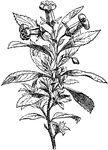
Escallonia
"Escallonia macrantha. Escallonia is a South American genus of trees or shrubs, of the natural order…
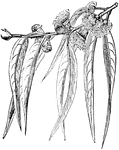
Blue Gum
A flowering branch of the Blue Gum Tree (Eucalyptus globulus), a tree in the Myrtaceae family of evergreen…

Ayapana
The Ayapana (Ayapana triplinervis) is a flowering shrub in the Asteraceae family of daisies.
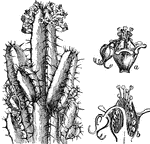
Resin Spurge
The Resin Spurge (Euphorbia resinifera) is a flowering plant that superficially resembles a cactus.…

Duckweed
Common duckweed, Lemna. The entire plant is reduced to a leaf-like expansion which bears a…

Fascicle of Mallow Flowers
The image shows a fascicle (bundle or cluster) of flowers of a mallow plant (Malvaceae).

Strawberry Flagellum
"In botany, a runner; a weak, creeping shoot sent out from the bottom of the stem, and rooting and forming…

Footer with Cherub
Decorative floral tailpiece with a cherub and birds, used as an ornamental footer.

Woodwaxen
The Woodwaxen or Dyer's Greenweed (Genista tinctoria) is a flowering plant in the legume family, Fabaceae.

Great Yellow Gentian
The Great Yellow Gentian (Gentian lutea) is a flowering plant in the Gentian family, Gentianaceae.

Mayflower
Epigaea repens (Mayflower or Trailing Arbutus) is a low, spreading shrub in the Ericaceae family. It…

Mayflower
Epigaea repens (Mayflower or Trailing Arbutus) is a low, spreading shrub in the Ericaceae family. It…

Man Surrounded by Vines & Flowers
An illustration of a man surrounded by decorative vines and flowers.

Capital Letter D with Floral Motif
Capital letter D designed and accented with a floral motif including flowers, leaves, lines, and shapes…

Indian Rice Grass
Indian Rice Grass (Zizania aquatica), also known as Wild Rice, or Water Oats, is found in swampy borders…
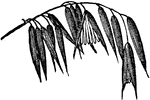
Indian Rice Grass
Indian Rice Grass (Zizania aquatica), also known as Wild Rice, or Water Oats, is found in swampy borders…
Indian Rice Grass
Indian Rice Grass (Zizania aquatica), also known as Wild Rice, or Water Oats, is found in swampy borders…
Indian Rice Grass
Indian Rice Grass (Zizania aquatica), also known as Wild Rice, or Water Oats, is found in swampy borders…

Meadow Foxtail Grass
The Meadow Foxtail (Alopecurus pratensis)has an erect, smooth stem, two or three feet high with swelling…

Slender Foxtail Grass
The Slender Foxtail (Alopecurus agretis) is distinguished from the meadow foxtail by its slender panicle,…

Slender Foxtail Grass
The Slender Foxtail is distinguished from the meadow foxtail by its slender panicle, larger spikelets…
Redtop Grass
The Redtop Grass (Agrostis vulgaris), also known as Burden's Grass, is a perennial grass with smooth,…

Redtop Grass
The Redtop Grass (Agrostis vulgaris), also known as Burden's Grass, is a perennial grass with smooth,…

Orchard Grass
Orchard Grass (Dactylis glomerata) also called Rough Cock's-foot, flowers in dense clusters. The stem…

Orchard Grass
Orchard Grass (Dactylis glomerata), also known as Rough Cock's-foot, flowers in dense clusters. The…

Goose Grass
Goose Grass appears around salt marshes, growing from six to twelve inches high and having a perennial…


